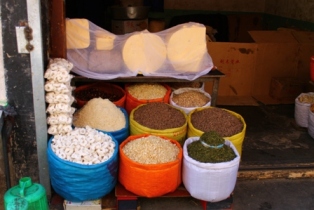Tibetan Diet Culture
Tibetan diet culture has a long history. According to the history records, as early as the First Century, Tibet has developed irrigated farmlands and begun to piece together these farmlands and grazing lands to provide the royal families and civilians with abundant roasted barley and ghee. Later, with the discovery of lake salt and tea and the importing of tea bowls from the Central Plains, Tibetan diet culture became richer.
Tea, roasted barley flour, yak-butter, and beef and mutton are called the "four treasures" of Tibetan diet. Tea has been loved by Tibetan since its introduction into Tibet, which is closely related with the plateau terrain, climate and the dietary components. In Tibet, there are many different edible methods as well as various customs in enjoying tea. Buttered tea is made by boiling brick tea or Tuo tea until the color is red and yellow, and then agitating with yak-butter and salt. If the tea is made with walnuts, raisins, eggs and milk added, it would taste even sweeter and more delicious, which is a top choice for entertaining guests. Sweet tea is also Tibetan's favorite drink. It is made after simmering black tea with added milk and white sugar. Going to a sweet tea house is a popular way of killing time for the Tibetan.
There is tea custom for drinking tea. The host will pour buttered tea to guests reverently after they sit down. Teapot will be waggled slightly several times at first and the bottom should be lower than the table when pouring tea. The guests can neither be too hurried to drink tea nor make any noise. They should blow the oil slick slowly and drink several times, drinking the better part of the cup of tea and leaving a little until the tea is poured by the host. There is a Tibetan proverb saying:"If you just drink one cup of tea, we will become enemies!" So it is auspicious to drink 3 cups of tea and the guests can't leave after drinking only one.
Tibetan people are quite particular about the tea set. The pots holding buttered tea are made of ceramics, copper, lead, silver or even gold, but only the aristocrats own the golden ones. Pottery pot is a beloved vessel by the local people, which is usually filled with buttered tea, kept warm on the ashes of crushed cattle manure and covered by a piece of cotton cloth, keeping the tea suitable for drinking all the time. Tibetan people treasure tea bowls including wooden bowls, china bowls and jade bowls, among which the most widely used are the wooden ones.
Yak-butter and tsampa have vital status in Tibetan food. Highland barley is the main crop in Tibet Plateau and the common types are white and purple. Highland barley is dried in the sun and fried and milled to powder by water mill, and then becomes tsampa, the staple food of the Tibetan.
Tsampa is more delicious when being eaten with yak-butter. Yak-butter is the butter extracted from the cows’ milk and goats’ milk. Because of the indigenous manufacturing, it contains more water contaminants and richer nutrients. The yak-butter, most Tibetans' favorite food, is with golden color, fragrant smell, and excellent taste.
Put a proper amount of buttered tea into a bowl, throw a piece of yak-butter to melt it, and then add tsampa and stir it to make "Ma Ba". The food fried with yak-butter, Gnocchi, quark, and brown sugar is called "Partse Markhu", whose taste is acid, crisp and sweet. Yak-butter with rice, sapodilla and brown sugar are called " Drolma Folding Pine", which is provided only on joyous or grand occasions.
Most Tibetans like eating meat, mainly yak meat and sheep meat. The Tibetans only eat even-hoof livestock and do not eat odd-hoof livestock. Meat can be eaten raw, or cooked with the method of air-drying, decocting, frying, boiling, and stewing. Facing a piece of fresh beef or gigot, the eaters will pull out the sharp Tibetan knife and cut the meat, and pick the meat into their mouth with the point of knife. The tradition of eating raw meat has now tapered, while eating air-dried meat is still very popular. With the dry climate across Tibet, the dried meat stays unspoiled for years.
Banquet also prevails in Tibet. Once people here encounter festivals or joyous things, they have the custom of hosting banquets. In a banquet of Tibet, the master and the guests sit on their own thick cushions, and have their meal from the table placed in front of them separately. Tibetan meal contains air dried meat, milk residue cake, ginseng fruit cake, grilled lamb, spicy tripe, sausage, lungs, stewed mutton, and stewed sheep head; The staple food contains Tsampa, cheese momo, Tibetan steamed stuffed bun, Tibetan dumplings, noodles and fried flour, etc.
When it comes to a banquet, it's mainly about highland barley wine, which means the wine is made with highland barley. The making process is very simple. First, wash and boil the highland barley, then add distiller's yeast when the temperature drops and seal it with a barrel or pot to make it ferment. After two or three days, add some cold water, then it's ready to be drank after a day or two. Highland barley wine is in orange luster, with sour and sweet taste and lower alcoholic contents. Drinking highland barley wine is particular about "three sips and one cup", which means taking one sip first, and filling up; taking another sip, and filling up again; taking the third sip, and filling up and then drink all.






